Charles E W Bean, Diaries, AWM38 3DRL 606/247/1 - 1917 - 1933 - Part 11
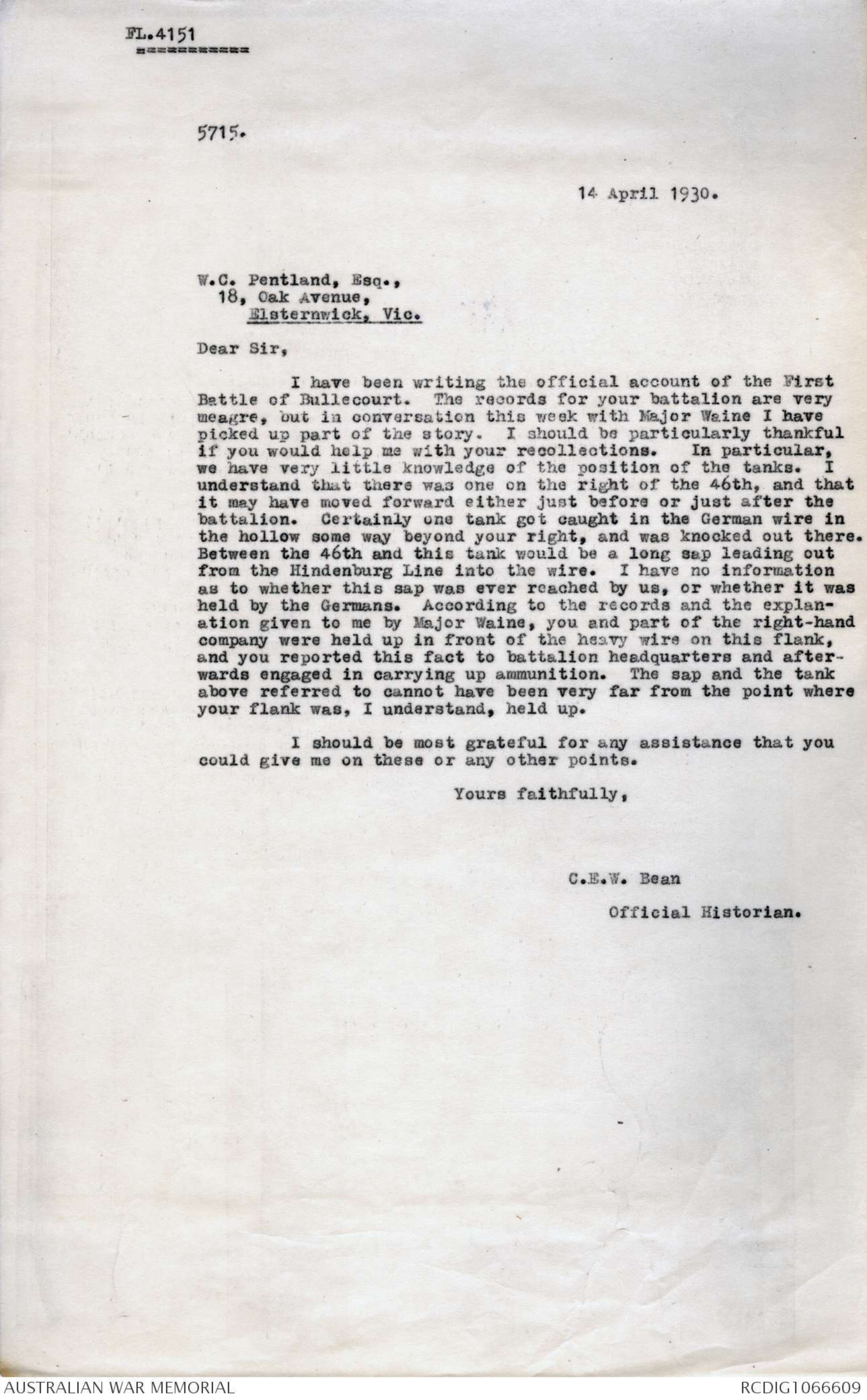

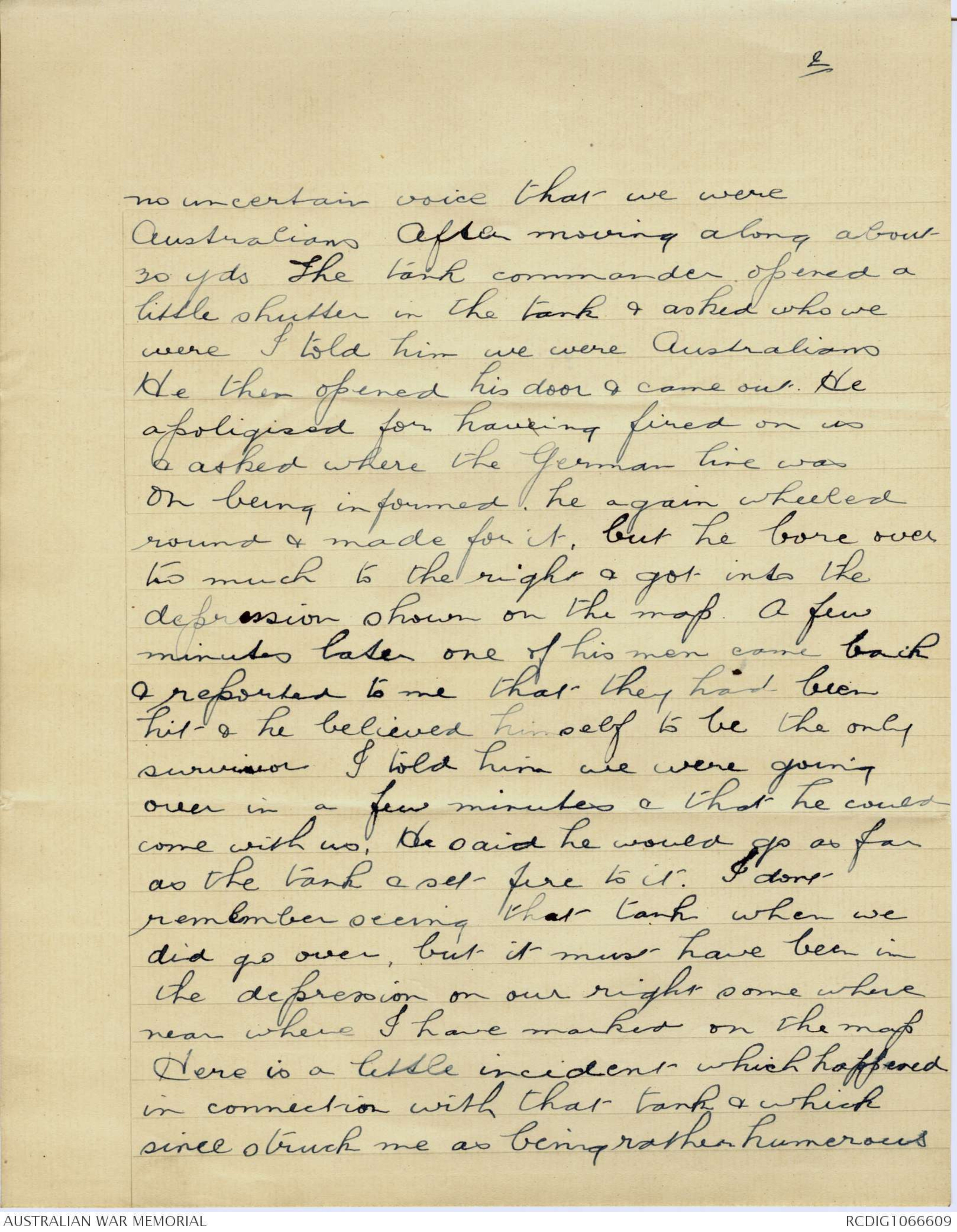
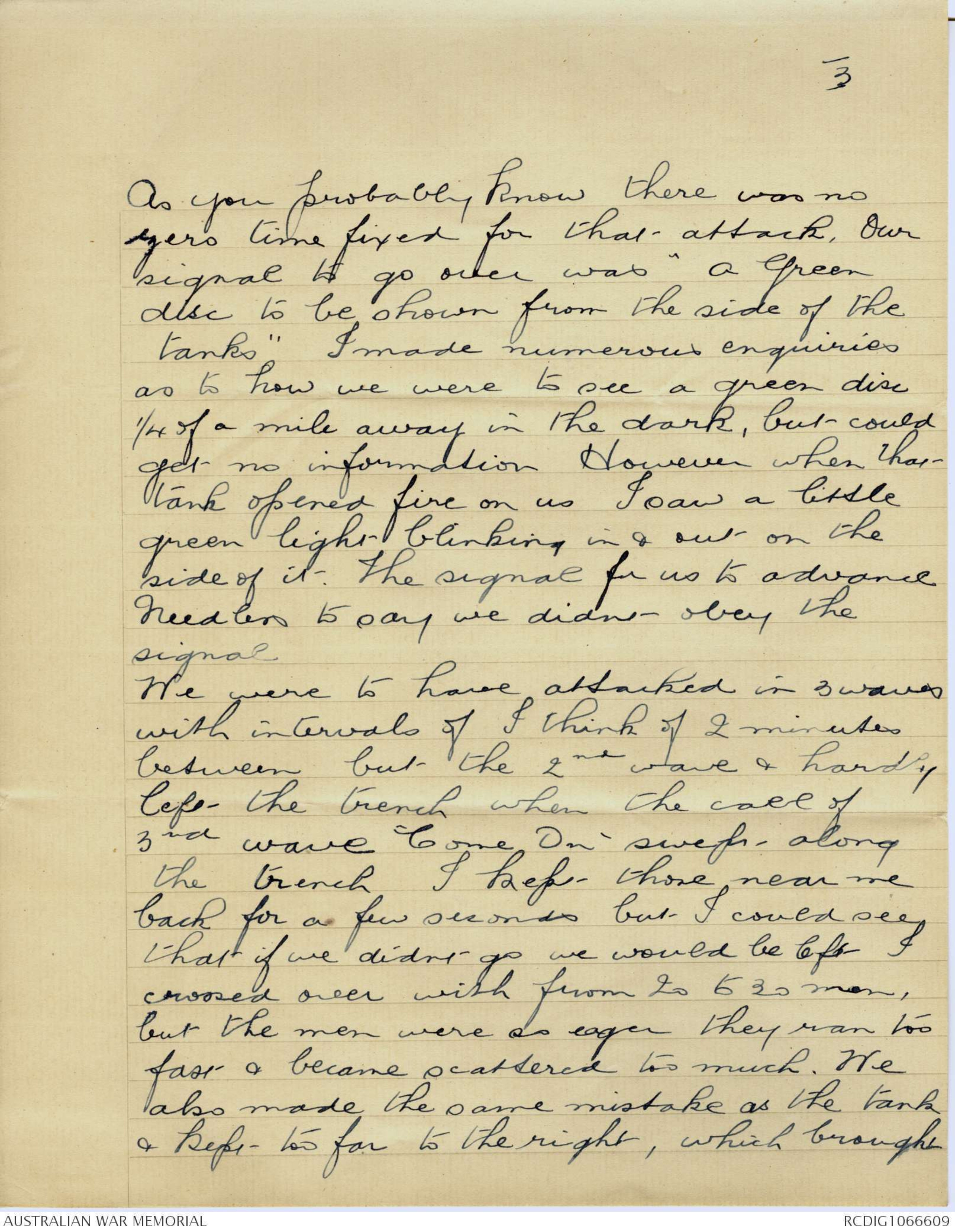
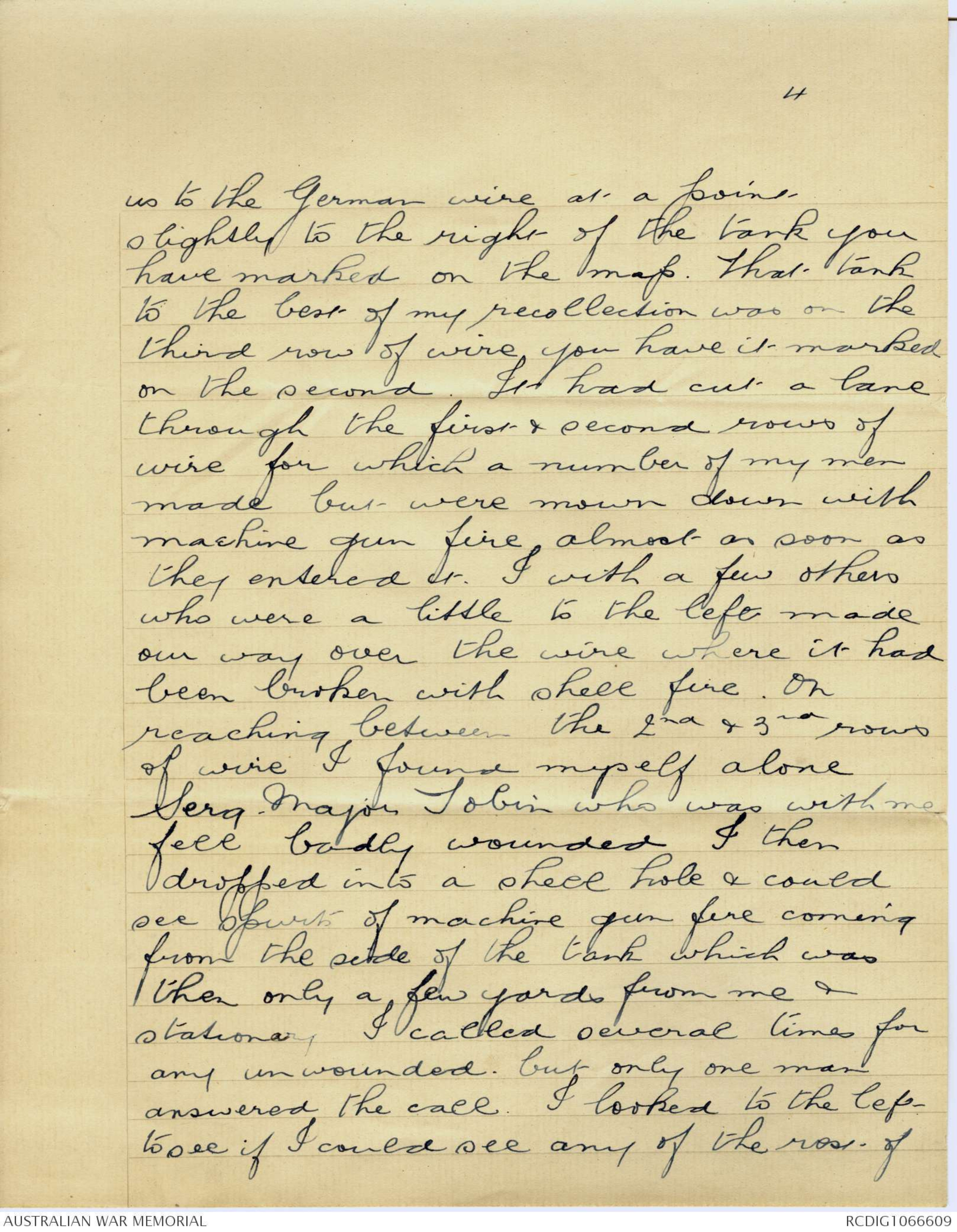
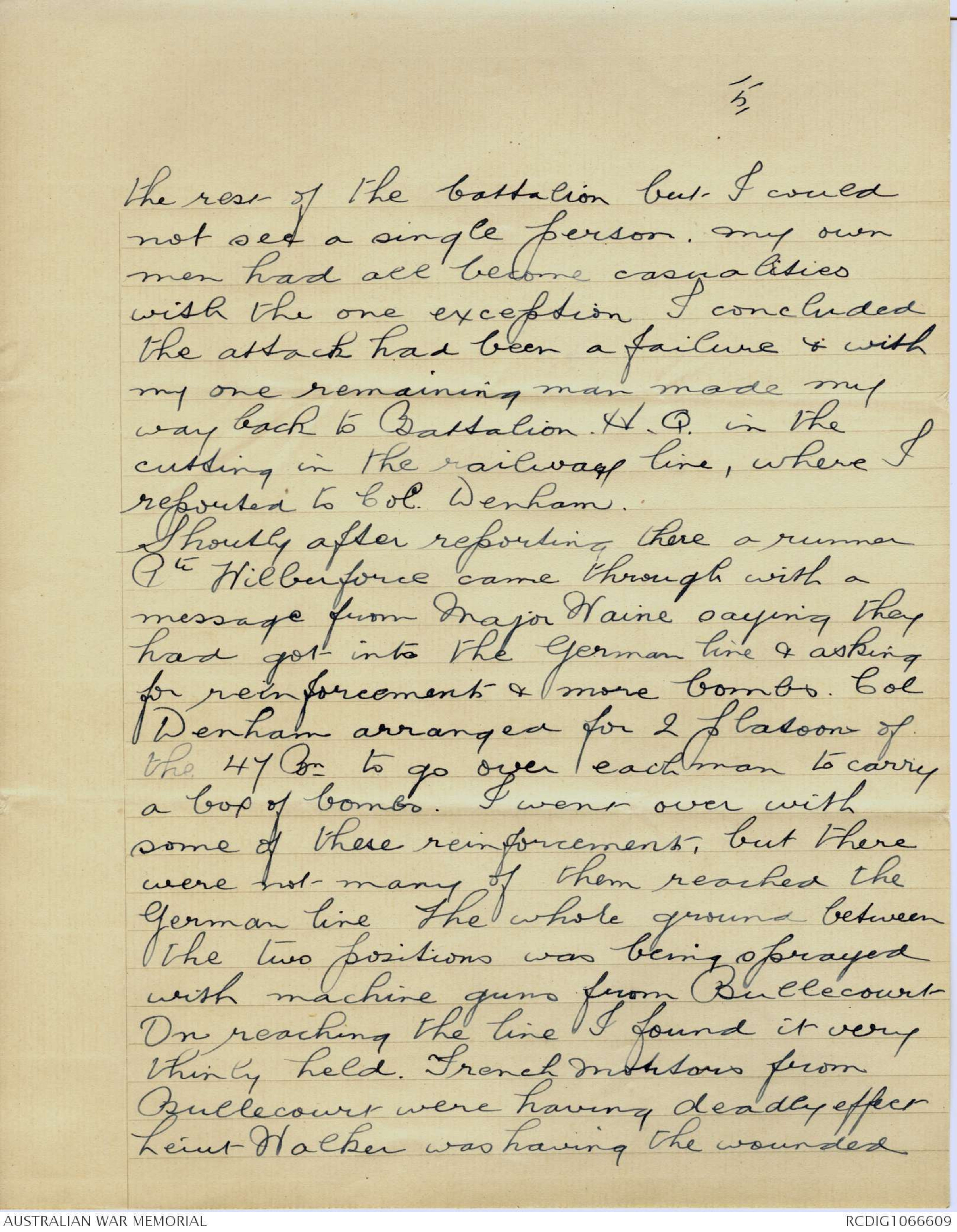
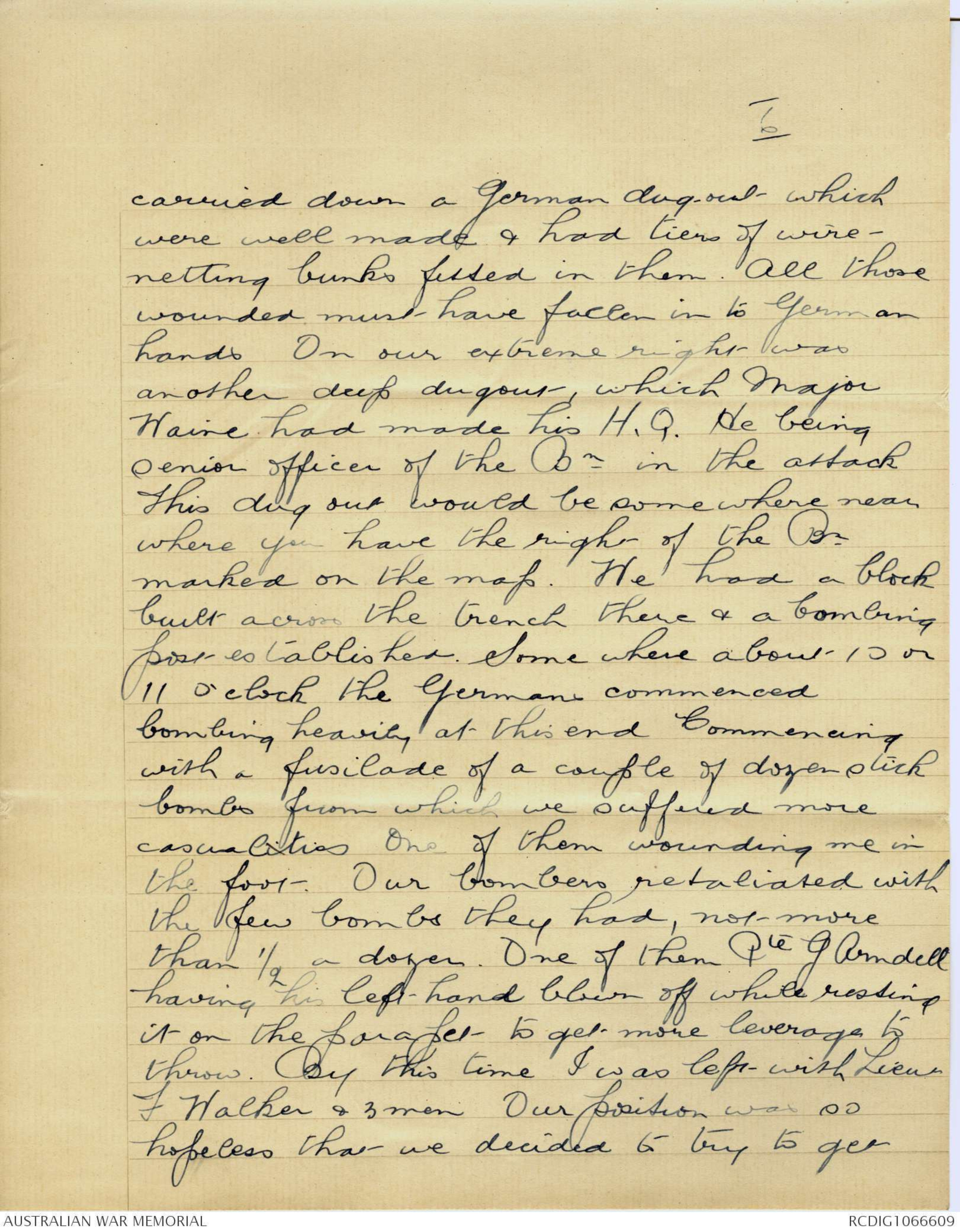
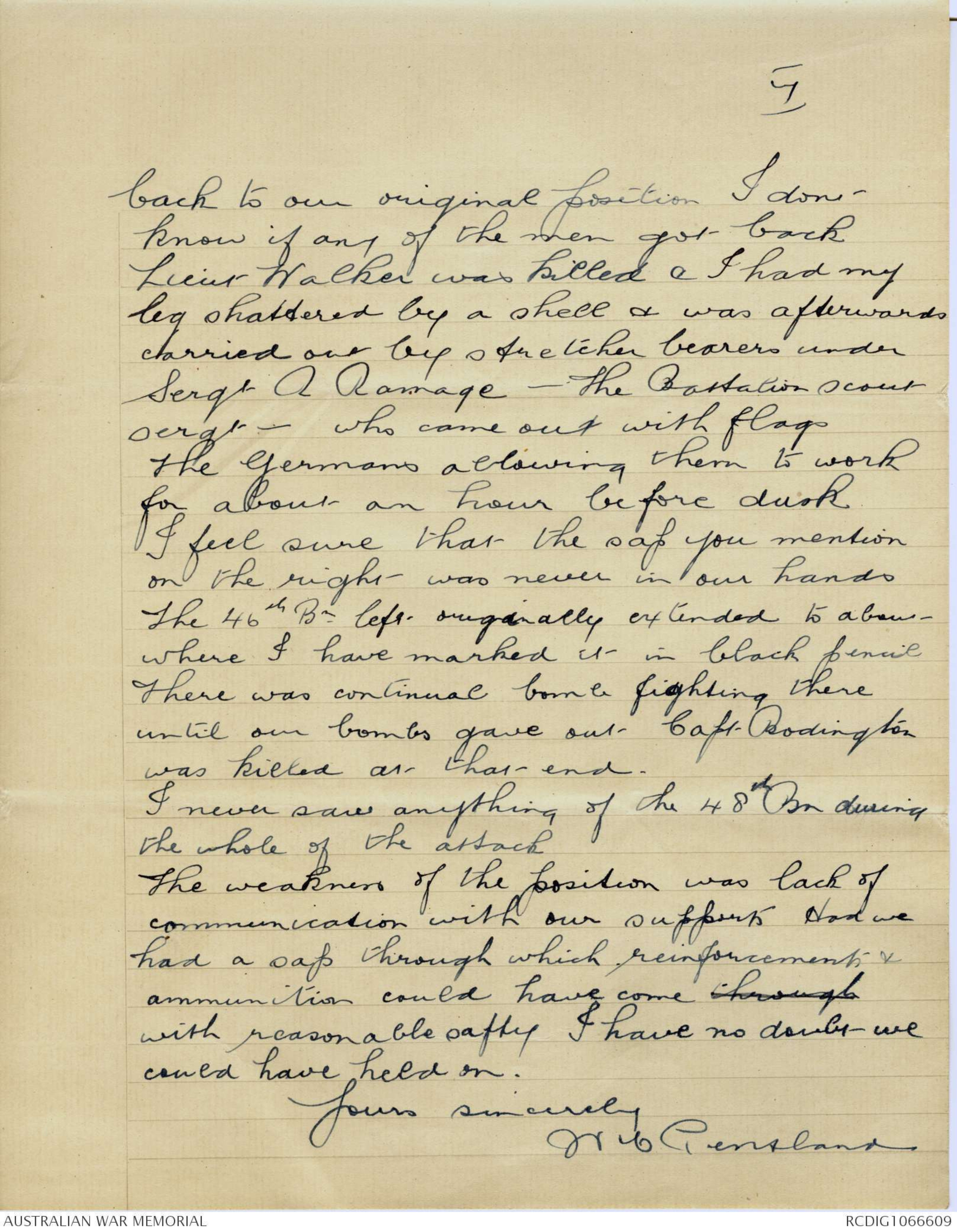
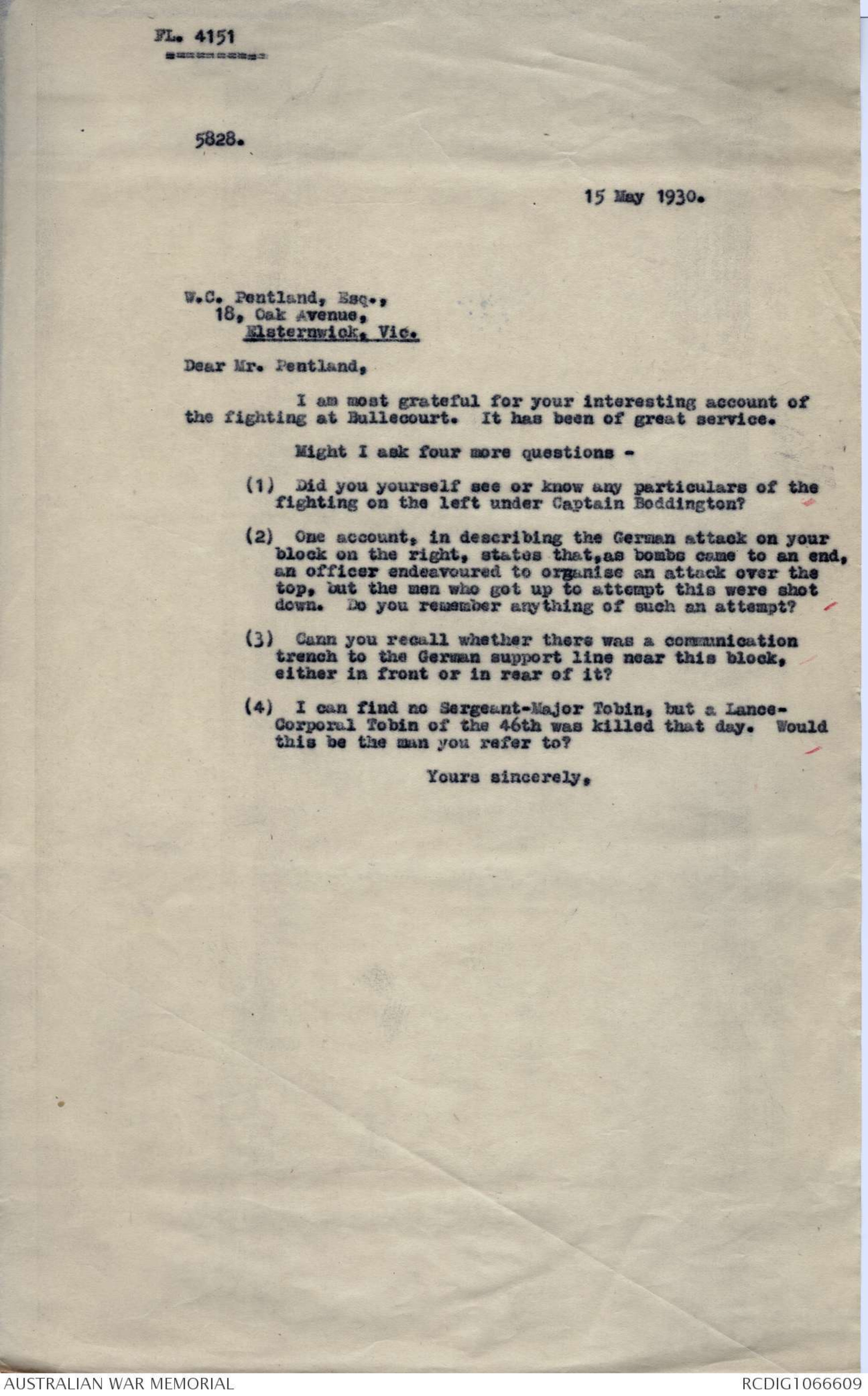
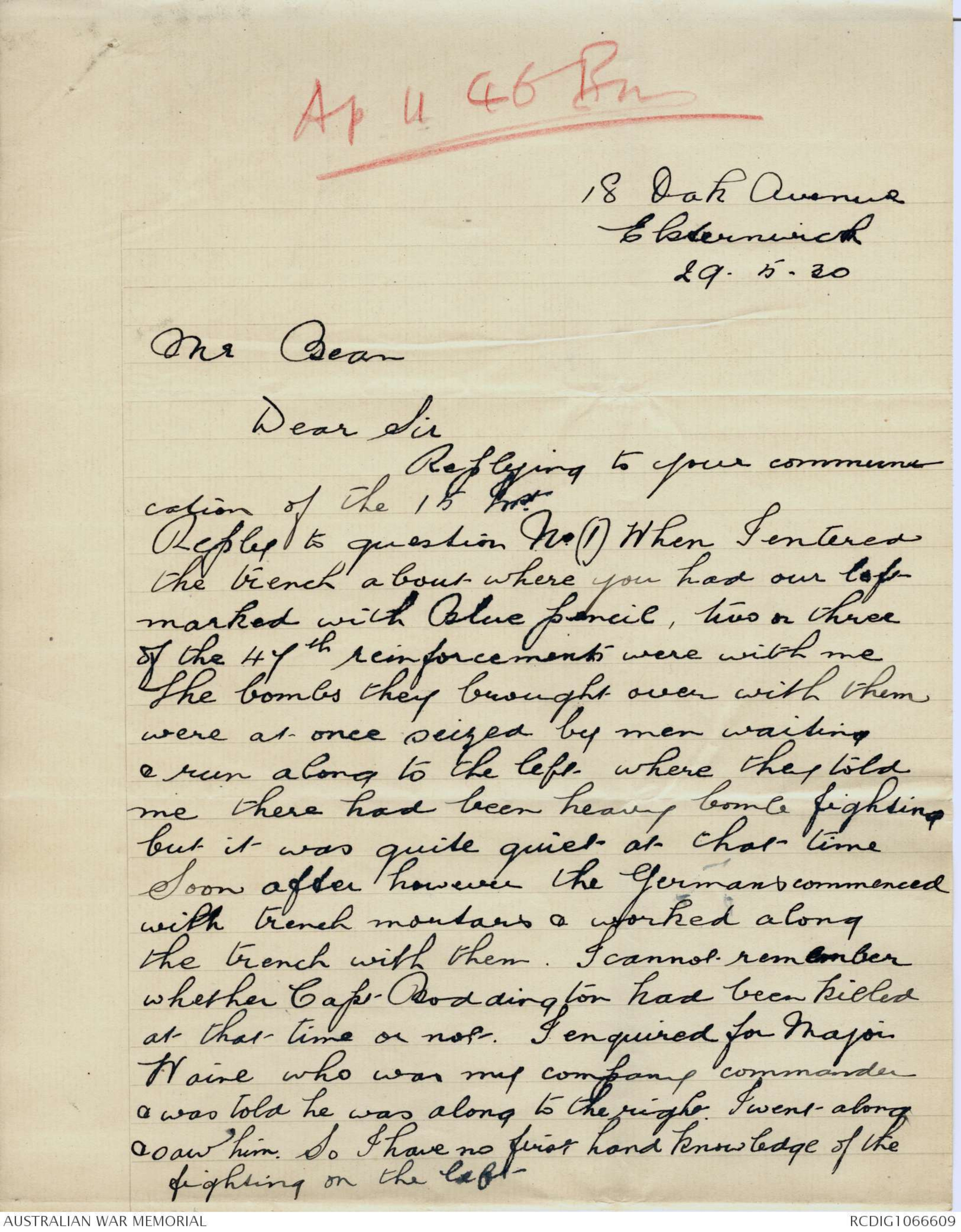
F.L. 4151
5715.
14 April 1930.
W.C. Pentland, Esq.,
18, Oak Avenue,
Elsternwick, Vic.
Dear Sir,
I have been writing the official account of the First
Battle of Bullecourt. The records for your battalion are very
meagre, but in conversation this week with Major Waine I have
pick up part of the story. I should be particularly thankful
if you would help me with your recollections. In particular,
we have very little knowledge of the position of the tanks. I
understand that there was one on the right of the 46th, and that
it may have moved forward either just before or just after the
battalion. Certainly one tank got caught in the German wire in
the hollow some way beyond your right, and was knocked out there.
Between the 46th and this tank would be a long sap leading out
from the Hindenburg Line into the wire. I have no information
as to whether this sap was ever reached by us, or whether it was
held by the Germans. According to the records and the explanation
given to me by Major Waine, you and part of the right-hand
company were held up in front of the heavy wire on this flank,
and you reported this fact to battalion headquarters and afterwards
engaged in carrying up ammunition. The sap and the tank
above referred to cannot have been very far from the point where
your flank was, I understand, held up.
I should be most grateful for any assistance that you
could give me on these or any other points.
Yours faithfully,
C.E.W.Bean
Official Historian.
[*H N.
First Bullecourt 46 Bn.*]
18 Oak Avenue
Elsternwick
1.5.30
Mr Bean
Dear Sir
Replying to your request
for information regarding the first
Bullecourt attack
Commencing from the night of the 10th
of April. The 46th Bn occupied the small
jumping off trench marked on the map
about 10. P.M.
We were to attack in 3 waves. I was in
charge of the 3rd wave of D Company
My position was at the right of the
jumping off trench.
Just before daybreak on the morning
of the 11th of April, the tanks came
up one of them passing about 30 yds
on my right. Mistaking us for the
Germans, it formed wheeled to its left,
moved along about 20 yds out from
our trench & parallel to the trench &
opened fire on us with a machine gun
The men in the trench called out in
2
no uncertain voice that we were
Australians After moving along about
30 yds the tank commander opened a
little shutter in the tank & asked who we
were I told him we were Australians
He then opened his door & came out. He
apoligised for having fired on us
& asked where the German line was
on being informed he again wheeled
round & made for it, but he bore over
too much to the right & got into the
depression shown on the map A few
minutes later one of his men came back
& reported to me that they had been
hit & he believed himself to be the only
survivor I told him we were going
over in a few minutes & that he could
come with us. He said he would go as far
as the tank & set fire to it. I dont
remember seeing that tank when we
did go over, but it must have been in
the depression on our right some where
near where I have marked on the map
Here is a little incident which happened
in connection with that tank & which
since struck me as being rather humerous
3
As you probably know there was no
zero time fixed for that attack. Our
signal to go over was "a Green
disc to be shown from the side of the
tanks". I made numerous enquiries
as to how we were to see a green disc
¼ of a mile away in the dark, but could
get no information However when that
tank opened fire on us I saw a little
green light blinking in & out on the
side of it. The signal for us to advance
needless to say we didnt obey the
signal.
We were to have attacked in 3 waves
with intervals of I think of 2 minutes
between but the 2nd wave & hardly
left the trench when the call of
3rd wave 'Come On' swept along
the trench. I kept those near me
back for a few seconds but I could see
that if we didnt go we would be left
crossed over with from 20 to 30 men,
but the men were as eager they ran too
fast & became scattered too much. We
also made the same mistake as the tank
& kept too far to the right, which brought
4
us to the German wire at a point,
slightly to the right of the tank you
have marked on the map. That tank
to the best of my recollection was on the
third row of wire you have it marked
on the second. It had cut a lane
through the first & second rows of
wire for which a number of my men
made but were mown down with
machine gun fire almost as soon as
they entered it. I with a few others
who were a little to the left made
our way over the wire where it had
been broken with shell fire. On
reaching between the 2nd & 3rd rows
of wire I found myself alone
Serg. Major Tobin who was with me
fell badly wounded I then
dropped into a shell hole & could
see spurts of machine gun fire coming
from the side of the tank which was
then only a few yards from me &
stationary I called several times for
any unwounded but only one man
answered the call. I looked to the left
to see if I could see any of the rest of
5
the rest of the battalion but I could
not see a single person. My own
men had all become casualities
with the one exception I concluded
that attack had been a failure & with
my one remaining man made my
way back to Battalion.H.Q. in the
cutting in the railway line, where I
reported to Col.Denham.
Shortly after reporting there a runner
Pte Wilberforce came through with a
message from Major Waine saying they
had got into the German line &asking
for reinforcements & more bombs. Col
Denham arranged for 2 platoons of
the 47 Bn to go over each man to carry
a box of bombs. I went over with
some of these reinforcements, but there
were not many of them reached the
German line the whole ground between
the two positions was being sprayed
with machine guns from Bullecourt
On reaching the line I found it very
thinly held. French mortars from
Bullecourt were having deadly effect
Lieut Walker was having the wounded
6
carried down a German dug-out which
were well made & had tiers of wire -
netting bunks fitted in them. All those
wounded must have fallen in to German
hands On our extreme right was
another deep dugout, which Major
Waine had made his H.Q. He being
senior officer of the Bn in the attack
This dug out would be some where near
where you have the right of the Bn
marked on the map. We had a block
built across the trench there & a bombing
post established. Some where about 10 or
11 o'clock the Germans commenced
bombing heavily at this end Commencing
with a fusilade of a couple of dozen stick
bombs from which we suffered more
casualities One of them wounding me in
the foot. Our bombers retaliated with
the few bombs they had, not more
than ½ a dozen. One of them Pte Condell
having his left hand blown off while resting
it on the parapet to get more leverage to
throw. By this time I was left with Lieut
F Walker & 3 men Our position was so
hopeless that we decided to try to get
7
back to our original position. I dont
know if any of the men got back
Lieut Walker was killed & I had my
leg shattered by a shell & was afterwards
carried out by stretcher bearers under
Sergt A Ramage - The Battalion scout
sergt - who came out with flags
The Germans allowing them to work
for about an hour before dusk
I feel sure that the sap you mention
on the right was never in our hands
The 46th Bn left originally extended to about
where I have marked it in black pencil
There was continual bomb fighting there
until our bombs gave out Capt. Bodington
was killed at that end.
I never saw anything of the 48th Bn during
the whole of the attack.
The weakness of the position was lack of
communication with our supports Had we
had a sap through which reinforcements, &
ammunition could have come through
with reasonable safety I have no doubt we
could have held on.
Yours sincerely
W C Pentland
FL. 4151
5828.
15 May 1930.
W.C. Pentland, Esq.,
18, Oak Avenue,
Elsternwick, Vic.
Dear Mr. Pentland,
I am most grateful for your interesting account of
the fighting at Bullecourt. It has been of great service.
Might I ask four more questions -
(1) Did you yourself see or know any particulars of the
fighting on the left under Captain Boddington?
(2) One account, in describing the German attack on your
block on the right, states that, as bombs came to an end,
an officer endeavoured to organise an attack over the
top, but the men who got up to attempt this were shot
down. Do you remember anything of such an attempt?
(3) Cann you recall whether there was a communication
trench to the German support line near this block,
either in front or in rear of it?
(4) I can find no Sergeant-Major Tobin, but a Lance-
Corporal Tobin of the 46th was killed that day. Would
this be the man you refer to?
Yours sincerely,
[*Ap 11 46 Bn*]
18 Oak Avenue
Elsternwick
29.5.30
Mr Bean
Dear Sir
Replying to your communication
of the 15 Inst.
Reply to question No. (1) When I entered
the trench about where you had our left
marked with Blue pencil, two or three
of the 47th reinforcements were with me
The bombs they brought over with them
were at once seized by men waiting
&run along to the left where they told
me there had been heavy bomb fighting
but it was quite quiet at that time
Soon after however the Germans commenced
with trench mortars & worked along
the trench with them. I cannot remember
whether Capt Boddington had been killed
at that time or not. I enquired for Major
Waine who was my company commander
& was told he was along to the right. I went along
& saw him. So I have no first hand knowledge of the
fighting on the left
 Deb Parkinson
Deb ParkinsonThis transcription item is now locked to you for editing. To release the lock either Save your changes or Cancel.
This lock will be automatically released after 60 minutes of inactivity.